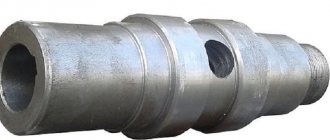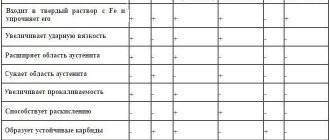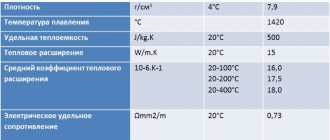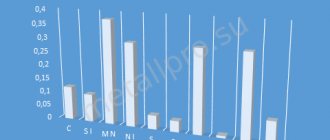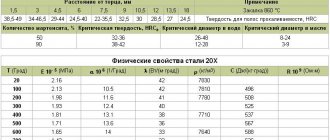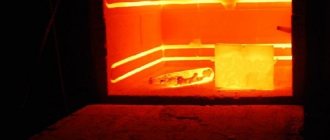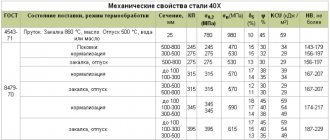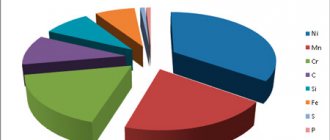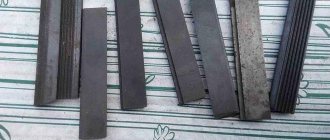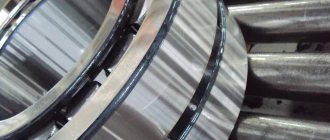Total information
Substitute: Steel 40ХФ, Steel 40ХР, Steel 45Х, Steel 38ХА, Steel 40ХН, Steel 40ХС
Type of delivery:
- Long products, including shaped steel: GOST 4543-71, GOST 2590-71, GOST 2591-71, GOST 2879-69, GOST 10702-78.
- Calibrated rod GOST 7414-75, GOST 8559-75, GOST 8560-78, GOST 1051-73.
- Polished rod and silver GOST 14955-77.
- Thick sheet GOST 1577-81, GOST 19903-74.
- Strip GOST 82-70, GOST 103-76, GOST 1577-81.
- Forgings and forged blanks GOST 8479-70. Pipes GOST 8731-87, GOST 8733-87, GOST 13663-68.
Purpose:
Axles, shafts, pinion shafts, plungers, rods, crankshafts and cam shafts, rings, spindles, mandrels, racks, ring gears, bolts, axle shafts, bushings and other upgradeable high-strength parts.
Normative documents
GOST 82-70. Rolled hot-rolled broadband universal steel. Steel 40X.
GOST 103-76. Hot-rolled steel strip. Assortment. Steel 40X.
GOST 1051-73. Calibrated rolled products. General technical conditions. Steel 40X.
GOST 1133-71. Forged steel round and square. Assortment. Steel 40X.
GOST 1577-93 Rolled thick sheets and wide sheets of structural quality steel. Technical conditions. Steel 40X.
GOST 2590-88. Hot-rolled round steel. Assortment. Steel 40X.
GOST 2591-88. Hot-rolled square steel. Assortment. Steel 40X.
GOST 2879-88. Hot-rolled hexagonal steel. Assortment. Steel 40X.
GOST 7417-75. Calibrated round steel. Assortment. Steel 40X.
GOST 8479-70. Forgings made of structural carbon and alloy steel. General technical conditions. Steel 40X.
GOST 8559-57. Calibrated square steel. Assortment. Steel 40X.
GOST 8560-78. Calibrated hexagonal rolled products. Assortment. Steel 40X.
GOST 10702-78. Rolled products from high-quality structural carbon and alloy steel for cold extrusion and upsetting. Technical conditions. Steel 40X.
GOST 13663-86. Profile steel pipes. Technical requirements. Steel 40X.
GOST 19903-74. Hot rolled sheet products. Assortment. Steel 40X.
Advantages and disadvantages
The pros and cons of a material are determined by its properties. Among the characteristics of 40X steel, hardness and endurance are of particular importance. Due to the presence of chromium in the alloy, parts made from it:
- have a high margin of strength and corrosion resistance;
- designed for high and long-term loads;
- resistant to extreme temperatures in the range from -40 to +425 degrees;
- withstand sudden temperature changes; the magnetic properties of 40X steel do not affect its performance characteristics;
- can be used in almost any external conditions;
- do not require cleaning or surface treatment;
- have a high limit of endurance and resistance to warping.
After hardening, the carbide contained in the alloy is completely dissolved, and the metal acquires higher corrosion resistance.
The chemical properties of 40X steel allow it to be used in aggressive wet environments. The material also lends itself well to cutting operations. In terms of weldability, the alloy belongs to group 4.
To avoid cracks in the welding seam, it should be preheated to 200-300 degrees.
Disadvantages of steel include temper brittleness and flake sensitivity, however, heat treatment technologies make it possible to reduce these properties to minimal values.
Chemical composition
Throughout the CIS, the characteristics and use of 40X steel are determined by GOST 4543-2016. It indicates the chemical composition and basic performance properties. Decoding the steel indicates the content of the main components - carbon and chromium.
The first two characters indicate the concentration of the main alloying element - carbon, it is in the range of 0.36-0.40%. It is difficult to maintain a more precise concentration during the metal smelting process.
The letter "X" indicates the presence of chromium, which improves the corrosion resistance of the material. However, its concentration does not exceed 0.8-1.1% and is insufficient to impart sufficient corrosion resistance to steel.
The alloy also contains other alloying additives that are not indicated in the markings, but impart certain properties to 40X steel:
- nickel – up to 0.3%;
- manganese – 0.5-0.8%;
- silicon – 0.17-0.37%;
- copper is present in very small quantities, about 0.035%, and does not significantly affect the mechanical properties of the alloy;
- The concentrations of harmful impurities - sulfur and phosphorus - are strictly regulated; their content does not exceed 0.035%.
Explanation of abbreviations
- temporary tensile strength (tensile strength), MPa
- elastic limit, MPa
- conditional yield strength, MPa
- relative elongation after rupture, %
- compressive yield strength, MPa
- short-term strength limit, MPa
- impact strength, determined on a sample with concentrators of the types U and V, respectively, J/cm2
- proportionality limit (yield strength for permanent deformation), MPa
- Brinell hardness
- Vickers hardness
- Rockwell hardness, C scale
- Rockwell hardness, B scale
- Shore hardness
- relative settlement at the appearance of the first crack, %
- ultimate torsional strength, maximum shear stress, MPa
- bending strength, MPa
Steel 40x: characteristics, application, table with markings and explanation
According to regulatory documents, the steel designation includes letters and numbers that indicate the approximate chemical composition of the alloy.
The first numbers in the record for low-carbon and medium-carbon steels show the amount of carbon in hundredths of a percent. The letters indicate alloying additives included in the material. Their content is indicated by the number following the letter designation.
When the element concentration is less than 1%, the number is missing. Thus, 40X steel contains 0.4% carbon and less than 1% chromium.
Physical and mechanical properties of the alloy
40X is a medium carbon steel and is most often used after hardening and high tempering. In this state, the steel structure consists of small, homogeneous particles.
This heat treatment is called improvement, as it provides a combination of high strength properties with toughness and ductility.
After quenching in oil at a temperature of 860 ℃ and tempering at 500 - 800 ℃, forgings made of 40X steel have the following properties.
| Strength characteristics | |
| Tensile strength σв, MPa | 655 |
| Yield strength σ0.2, MPa | 490 |
| Brinell hardness HB | 212 – 248 |
| Plastic characteristics | |
| Relative elongation δ, % | 15 |
| Impact strength KCU, J/cm2 | 59 |
To increase strength properties, reduce the steel tempering temperature. Tempering at 200 ℃ allows you to increase the yield strength to 1560 MPa, the tensile strength to 1760 MPa, the hardness to 552 HB, while the impact strength will decrease to 29 J/cm2.
Steel is difficult to weld and is prone to the formation of brittle martensitic structures in the heat-affected zone of the weld.
Obtaining a high-quality connection during manual electric arc and electroslag welding is possible by using an additional heating source.
To reduce residual stresses, heat treatment of the seams is required. Spot resistance welding can be performed without heating.
Application areas of 40X steel
40X belongs to structural steels and is used in the production of machine parts and machine tools, fasteners.
High strength combined with sufficient ductility makes it possible to produce parts of complex configurations that are subject to increased loads: gears, crankshafts, racks.
It is advisable to use 40X steel for the manufacture of cylindrical parts (shafts, spindles, rods, plungers, bolts, axles) with a diameter of no more than 20 mm. This parameter is limited by the depth of hardenability of the alloy.
Steel 40X shows good properties when processed by pressure, so it is used for the manufacture of parts by stamping, forging, and rolling. GOST regulates pipes and various sheet and shaped products made from 40X.
Analogues and nomenclature
Steel grade 40X can be replaced with domestic analogues:
- 45X;
- 38ХА;
- 40ХН;
- 40ХС;
- 40HF;
- 40XP.
Foreign analogues have different markings, but the compositions of these alloys are approximately the same:
- G51400 and H51350 - United States;
- 37Cr4, 41Cr4, 41CrS4 – Germany;
- 35Cr, 38CrA, 40Cr and 40CrA – China;
- SCr435, SCr440 – Japan;
- 37Cr4, 41Cr4 – France;
- 36CrMn4 – Italy;
- 2245 – Sweden;
- 14140 – Czech Republic.
The classification of structural alloy steels is regulated by GOST 4543-71. It specifies technical conditions for different types of rental. According to the characteristics of steel 40X, GOST 4543-71 classifies it as chromium alloys and establishes:
- maximum content of impurities that negatively affect the technological properties of the material, for example, sulfur and phosphorus;
- heat treatment modes.
Steel is supplied in the form of:
- long products according to several standards;
- calibrated rod;
- ground and silver rod according to GOST 14955-77;
- thick sheet and strips;
- forgings, according to GOST 8479-70;
- pipes and connecting parts to them.
Technical characteristics of steel 14Х17Н2
Domestic
The possibility of replacing with a material of a similar composition must be analyzed in each case; there is no universal solution.
Domestic substitutes:
- 38HA. Carbon - 0.38%, chromium - up to 1.5%, "A" - designation of a high quality standard alloy;
- 40ХН. Carbon - 0.40%, alloyed with 1.1% chromium and 1.5% nickel;
- 40ХС. The amount of carbon and chromium remains the same, the additional alloying element is silicon in a concentration of 1.2-1.5%
- 40HFA. Carbon - 0.40%, alloying element - vanadium 1.1%. "A" - iron-carbon alloy of a high quality standard. Used at temperatures up to +400°C
Application: production of workpieces and end products with enhanced wear resistance (gears, bearings, shafts, axles), incl. for gas and oil production enterprises (pipelines, buildings).
Foreign analogues of Steel 40Х
| USA | Germany | Japan | France | England | European Union | Italy | Belgium | Spain |
| — | DIN,WNr | JIS | AFNOR | B.S. | EN | UNI | NBN | UNE |
| 5135 | 1,7034 | SCr435 | 37Cr4 | 37Cr4 | 1.7034 | 36CrMn4 | 37Cr4 | 37Cr4 |
| 5140 | 1,7035 | SCr435H | 38C4 | 41Cr4 | 1.7035 | 36CrMn5 | 41Cr4 | 38Cr4 |
| 5140H | 1,7045 | SCr440 | 38C4FF | 530A36 | 1.7039 | 37Cr4 | 45C4 | 38Cr4DF |
| 5140RH | 37Cr4 | SCr440H | 41Cr4 | 530A40 | 37Cr4 | 38Cr4KB | 41Cr4 | |
| G51350 | 41Cr4 | 42C4 | 530H36 | 37Cr4KD | 38CrMn4KB | 41Cr4DF | ||
| G51400 | 41CrS4 | 42C4TS | 530H40 | 41Cr4 | 41Cr4 | 42Cr4 | ||
| H51350 | 42Cr4 | 530M40 | 41Cr4KD | 41Cr4KB | F.1201 | |||
| H51400 | 41CrS4 | F.1202 | ||||||
| F.1210 | ||||||||
| F.1211 | ||||||||
| China | Sweden | Bulgaria | Hungary | Poland | Romania | Czech | Australia | South Korea |
| G.B. | SS | BDS | MSZ | PN | STAS | CSN | AS | KS |
| 35Cr | 2245 | 37Cr4 | 37Cr4 | 38HA | 40Cr10 | 14140 | 5132H | SCr435 |
| 38CrA | 40Ch | 41Cr4 | 40H | 40Cr10q | 5140 | SCr435H | ||
| 40Cr | 41Cr4 | Cr2Z | SCr440 | |||||
| 40CrA | Cr3Z | SCr440H | ||||||
| 40CrH | ||||||||
| 45Cr | ||||||||
| 45CrH | ||||||||
| ML38CrA | ||||||||
| ML40Cr |
Legend
| Mechanical properties | |
| σB | temporary tensile strength (tensile strength), MPa |
| σ0.2 | conditional yield strength, MPa |
| σcom | compressive strength, MPa |
| σco0.2 | compressive yield strength, MPa |
| σ0.05 | elastic limit, MPa |
| σben | bending strength, MPa |
| σ-1 | endurance limit during bending test with a symmetrical loading cycle, MPa |
| δ5, δ4, δ10 | relative elongation after rupture, % |
| ψ | relative narrowing, % |
| ν | relative shift, % |
| ε | relative settlement at the appearance of the first crack, % |
| τK | ultimate torsional strength, maximum shear stress, MPa |
| τ-1 | endurance limit during torsion testing with a symmetrical loading cycle, MPa |
| KCU and KCV | impact strength, determined on a sample with concentrators of the U and V types, J/cm2 |
| HRСе and HRB | Rockwell hardness (scale C and B respectively) |
| HB | Brinell hardness |
| H.V. | Vickers hardness |
| HSD | Shore hardness |
| Physical properties | |
| E | normal modulus of elasticity, GPa |
| G | modulus of elasticity in torsional shear, GPa |
| ρn | density, kg/m3 |
| λ | thermal conductivity coefficient, W/(m∙°C) |
| ρ | electrical resistivity, Ohm∙m |
| α | linear thermal expansion coefficient, 10-61/°С |
| With | specific heat capacity, J/(kg∙°С) |
GOST 4543-71
When producing steel, manufacturers are guided by GOST 4543-71 standards. It defines the technical conditions for rolled alloy structural steel. Its standards apply to such types of rolled products as ingots, forgings, etc.
GOST 4543-71 gives a clear classification of structural alloy steels. In accordance with it, steel grade 40X belongs to the group of chromium steels.
The same document defines quality parameters, that is, it determines the maximum permissible amount of impurities that affect the technical characteristics of structural alloy steel. Such impurities include sulfur, phosphorus, copper and some others.
By the way, the same document defines the heat treatment regimes for rolled products.
Alloy properties
The physical and mechanical properties of 40X steel allow it to withstand high loads without destroying its structure:
- density – 7820 kg/m3; elastic modulus – 2.14Х10-5;
- coefficient of linear expansion – 11.9Х106 1/deg.;
- electrical resistivity – 210Х109 Ohm*m;
- impact strength – 160 J/cm2;
- forging temperature – from 1250 to 800 degrees.
Almost all indicators change depending on temperature. As it increases, the following increases:
- resistivity;
- linear expansion coefficient;
- specific heat.
The inverse dependence on temperature is demonstrated by:
- elastic modulus;
- metal density;
- coefficient of thermal conductivity.
An important characteristic is the yield strength indicator. It is determined by the magnitude of the load at which irreversible deformations occur in the product. The indicator depends on several factors: heat treatment mode; type of alloying additives and amount of harmful impurities; crystal lattice structure.
For steel 40X, the yield strength decreases in the temperature range of 100-500 degrees from 490 to 345 MPa. Tempering brittleness and flake sensitivity have a negative impact on the quality of the alloy. Steel is difficult to weld and requires preheating and subsequent heat treatment.
Mechanical properties
Mechanical properties
| Heat treatment, delivery condition | Section, mm | σ0.2, MPa | σB, MPa | δ5, % | ψ, % | KCU, J/m2 | HB |
| Bar. Hardening 860 °C, oil. Temperature 500 °C, water or oil | 25 | 780 | 980 | 10 | 45 | 59 | |
| Forgings. Normalization. KP 245 | 500-800 | 245 | 470 | 15 | 30 | 34 | 143-179 |
| Forgings. Normalization. KP 275 | 300-500 | 275 | 530 | 15 | 32 | 29 | 156-197 |
| Forgings. Hardening, tempering. KP 275 | 500-800 | 275 | 530 | 13 | 30 | 29 | 156-197 |
| Forgings. Normalization. KP 315 | <100 | 315 | 570 | 17 | 38 | 39 | 167-207 |
| Forgings. Normalization. KP 315 | 100-300 | 315 | 570 | 14 | 35 | 34 | 167-207 |
| Forgings. Hardening, tempering. KP 315 | 300-500 | 315 | 570 | 12 | 30 | 29 | 167-207 |
| Forgings. Hardening, tempering. KP 315 | 500-800 | 315 | 570 | 11 | 30 | 29 | 167-207 |
| Forgings. Normalization. KP 345 | <100 | 345 | 590 | 18 | 45 | 59 | 174-217 |
| Forgings. Normalization. KP 345 | 100-300 | 345 | 590 | 17 | 40 | 54 | 174-217 |
| Forgings. Hardening, tempering. KP 345 | 300-500 | 345 | 590 | 14 | 38 | 49 | 174-217 |
| Forgings. Hardening, tempering. KP 395 | <100 | 395 | 615 | 17 | 45 | 59 | 187-229 |
| Forgings. Hardening, tempering. KP 395 | 100-300 | 395 | 615 | 15 | 40 | 54 | 187-229 |
| Forgings. Hardening, tempering. KP 395 | 300-500 | 395 | 615 | 13 | 35 | 49 | 187-229 |
| Forgings. Hardening, tempering. KP 440 | <100 | 440 | 635 | 16 | 45 | 59 | 197-235 |
| Forgings. Hardening, tempering. KP 440 | 100-300 | 440 | 635 | 14 | 40 | 54 | 197-235 |
| Forgings. Hardening, tempering. KP 490 | <100 | 490 | 655 | 16 | 45 | 59 | 212-248 |
| Forgings. Hardening, tempering. KP 490 | 100-300 | 490 | 655 | 13 | 40 | 54 | 212-248 |
Mechanical properties at elevated temperatures
| test t, °C | σ0.2, MPa | σB, MPa | δ5, % | ψ, % | KCU, J/m2 |
| Hardening 830 °C, oil. Vacation 550 °C, | |||||
| 200 | 700 | 880 | 15 | 42 | 118 |
| 300 | 680 | 870 | 17 | 58 | |
| 400 | 610 | 690 | 18 | 68 | 98 |
| 500 | 430 | 490 | 21 | 80 | 78 |
| A sample with a diameter of 10 mm and a length of 50 mm is forged and annealed. The strain rate is 5 mm/min, the strain rate is 0.002 1/s. | |||||
| 700 | 140 | 175 | 33 | 78 | |
| 800 | 54 | 98 | 59 | 98 | |
| 900 | 41 | 69 | 65 | 100 | |
| 1000 | 24 | 43 | 68 | 100 | |
| 1100 | 11 | 26 | 68 | 100 | |
| 1200 | 11 | 24 | 70 | 100 | |
Mechanical properties depending on tempering temperature
| holiday t, °С | σ0.2, MPa | σB, MPa | δ5, % | ψ, % | KCU, J/m2 | HB |
| Quenching 850 °C, water | ||||||
| 200 | 1560 | 1760 | 8 | 35 | 29 | 552 |
| 300 | 1390 | 1610 | 8 | 35 | 20 | 498 |
| 400 | 1180 | 1320 | 9 | 40 | 49 | 417 |
| 500 | 910 | 1150 | 11 | 49 | 69 | 326 |
| 600 | 720 | 860 | 14 | 60 | 147 | 265 |
Mechanical properties depending on the section
| Section, mm | σ0.2, MPa | σB, MPa | δ5, % | ψ, % | KCU, J/m2 | HB |
| Quenching 840-860 °C, water, oil. Vacation 580-650 °C, water, air. | ||||||
| 101-200 | 490 | 655 | 15 | 45 | 59 | 212-248 |
| 201-300 | 440 | 635 | 14 | 40 | 54 | 197-235 |
| 301-500 | 345 | 590 | 14 | 38 | 49 | 174-217 |
Mechanical properties depending on the section
| Section, mm | σ0.2 (MPa) | σв(MPa) | δ4 (%) | ψ % | KCU (kJ/m2) | HB |
| Quenching 840-860 °C, water, oil. Vacation 580-650 °C, water, air. | ||||||
| 101-200 | 490 | 655 | 15 | 45 | 59 | 212-248 |
| 201-300 | 440 | 635 | 14 | 40 | 54 | 197-235 |
| 301-500 | 345 | 590 | 14 | 38 | 49 | 174-217 |
Mechanical properties of Steel 40X depending on tempering temperature
| Temperature, °C | σ0.2 (MPa) | σв(MPa) | δ5 (%) | ψ % | KCU (kJ/m2) | HB |
| 200 | 1560 | 1760 | 8 | 35 | 29 | 552 |
| 300 | 1390 | 1610 | 8 | 35 | 20 | 498 |
| 400 | 1180 | 1320 | 9 | 40 | 49 | 417 |
| 500 | 910 | 1150 | 11 | 49 | 69 | 326 |
| 600 | 720 | 860 | 14 | 60 | 147 | 265 |
Mechanical properties at elevated temperatures
| Test temperature, °C | σ0.2 (MPa) | σв(MPa) | δ5 (%) | ψ % | KCU (kJ/m2) |
| Hardening 830 °C, oil. Vacation 550 °C | |||||
| 200 | 700 | 880 | 15 | 42 | 118 |
| 300 | 680 | 870 | 17 | 58 | |
| 400 | 610 | 690 | 18 | 68 | 98 |
| 500 | 430 | 490 | 21 | 80 | 78 |
| A sample with a diameter of 10 mm and a length of 50 mm is forged and annealed. Strain rate 5 mm/min, strain rate 0.002 1/s | |||||
| 700 | 140 | 175 | 33 | 78 | — |
| 800 | 54 | 98 | 59 | 98 | |
| 900 | 41 | 69 | 65 | 100 | |
| 1000 | 24 | 43 | 68 | 100 | |
| 1100 | 11 | 26 | 68 | 100 | |
| 1200 | 11 | 24 | 70 | 100 | |
Technological properties
| Forging temperature |
| Start 1250°C, end 800°C. Sections up to 350 mm are cooled in air. |
| Weldability |
| difficult to weld. Welding methods: RDS, ESW. Heating and subsequent heat treatment are required. KTS - subsequent heat treatment is required. |
| Machinability |
| In the hot-rolled state at HB 163-168, σB = 610 MPa Ku tv.alloy. = 0.20, Ku b.st. = 0.95. |
| Tendency to release ability |
| inclined |
| Flock sensitivity |
| sensitive |
Physical properties
| Test temperature, °C | 20 | 100 | 200 | 300 | 400 | 500 | 600 | 700 | 800 | 900 |
| Modulus of normal elasticity, E, GPa | 214 | 211 | 206 | 203 | 185 | 176 | 164 | 143 | 132 | |
| Modulus of elasticity under torsional shear G, GPa | 85 | 83 | 81 | 78 | 71 | 68 | 63 | 55 | 50 | |
| Density, ρn, kg/cm3 | 7850 | 7800 | 7650 | |||||||
| Thermal conductivity coefficient W/(m °C) | 41 | 40 | 38 | 36 | 34 | 33 | 31 | 30 | 27 | |
| Ud. electrical resistance (ρ, NΩ m) | 278 | 324 | 405 | 555 | 717 | 880 | 1100 | 1330 | ||
| Test temperature, °C | 20- 100 | 20- 200 | 20- 300 | 20- 400 | 20- 500 | 20- 600 | 20- 700 | 20- 800 | 20- 900 | 20- 1000 |
| Linear expansion coefficient (α, 10-6 1/°С) | 11.8 | 12.2 | 13.2 | 13.7 | 14.1 | 14.6 | 14.8 | 12.0 | ||
| Specific heat capacity (s, J/(kg °C)) | 466 | 508 | 529 | 563 | 592 | 622 | 634 | 664 |
Impact strength
Impact strength, KCU, J/cm2
| Delivery condition, heat treatment | +20 | -25 | -40 | -70 |
| Hardening 850 °C, oil. Vacation 650 °C. | 160 | 148 | 107 | 85 |
| Hardening 850 °C, oil. Vacation 580 °C. | 91 | 82 | 54 |
Endurance limit
| σ-1, MPa | τ-1, MPa | n | σB, MPa | σ0.2, MPa | Heat treatment, steel condition |
| 363 | 1E+6 | 690 | |||
| 470 | 1E+6 | 940 | |||
| 509 | 960 | 870 | |||
| 333 | 240 | 5E+6 | 690 | ||
| 372 | Quenching 860 °C, oil, tempering 550 °C. |
Hardenability
Hardening 850 °C. Hardness for hardenability strips HRCе.
| Distance from the end, mm / HRC e | |||||||||
| 1.5 | 4.5 | 6 | 7.5 | 10.5 | 13.5 | 16.5 | 19.5 | 24 | 30 |
| 50.5-60.5 | 48-59 | 45-57.5 | 39-5-57 | 35-53.5 | 31.5-50.5 | 28.5-46 | 27-42.5 | 24.5-39.5 | 22-37.5 |
| Heat treatment | Quantity of martensite, % | Crit.dia. in water, mm | Crit.dia. in oil, mm | Crete. hardness, HRCе |
| Hardening | 50 | 38-76 | 16-48 | 43-46 |
| 90 | 23-58 | 6-35 | 49-53 |
Critical point temperature
| Critical point | °C |
| Ac1 | 743 |
| Ac3 | 815 |
| Ar3 | 730 |
| Ar1 | 693 |
| Mn | 325 |
Brinnell hardness GOST 4543-2016
In the indentation test, steel shows a result of 217 units when using a steel ball for alloys with a hardness of more than 450 conventional units.
The standard uses annealed and high-annealed products, as well as hot-worked, forged and tempered products. Product cut - from 5 mm or more.
Weldability
Difficult to weld. Welding methods:
- RDS (manual arc welding), ESW (electroslag welding). Heating and subsequent heat treatment are required.
- KTS (resistance welding) - subsequent heat treatment is required.
Steel grade 40X: characteristics, hardening, GOST standards and industrial use
Mechanical engineering, instrument making, machine tool building and other areas of industry in the production process use a huge amount of materials, both classical, known for decades and hundreds of years, and completely new, modern ones.
Steel is one of the classic and widely used materials.
The classification of steels by chemical composition provides for their division into alloyed (with the introduction of alloying elements that provide the alloy with the necessary mechanical and physical properties) and carbon.
Steel 40x is a structural alloy alloy. The word “structural” indicates that the material is used for the manufacture of various mechanisms, structures and parts used in mechanical engineering and construction, and has a certain set of chemical, physical and mechanical properties.
Chemical composition
The number 40 in the marking indicates that the percentage of carbon in the alloy ranges from 0.36 to 0.44, and the letter x indicates the presence of the alloying element chromium in an amount of no less than 0.8 and no more than 1.
1 percent. Alloying steel with chromium gives it the property of resistance to corrosion in an oxidizing environment and atmosphere. In other words, steel acquires stainless properties .
In addition, chromium determines the structure of the alloy, its technological and mechanical characteristics.
The remaining chemical elements are included in steel x 40 in the following quantities:
- no more than 97% iron;
- 0.5 – 0.8% manganese;
- 0.17 – 0.37% silicon;
- no more than 0.3% copper;
- no more than 0.3% nickel;
- no more than 0.035% phosphorus;
- no more than 0.035% sulfur.
physical characteristics
Almost all physical properties of metals depend directly or inversely on temperature . Indicators such as resistivity, coefficient of linear expansion and specific heat capacity increase with increasing temperature, while the density of steel, its modulus of elasticity and thermal conductivity, on the contrary, decrease with increasing temperature.
Another physical characteristic, called mass, does not depend on practically anything. The sample can be subjected to heat treatment, cooled, processed, given different shapes, and the mass will remain unchanged.
The physical characteristics of all known grades of domestic steels and alloys, including the grade described, are summarized in tables and placed in reference books on metal science.
Steel in its original state is a fairly plastic mass and can be processed by deformation. It can be forged, stamped, rolled.
To change the mechanical properties and achieve the required qualities, heat treatment of the metal is used.
The essence of thermal or heat treatment is the use of a set of operations for heating, holding and cooling hard metal alloys.
As a result of such processing, the alloy changes its internal structure and acquires certain properties necessary for the manufacturer and consumer.
Critical points
Critical points are temperatures at which the structure of steel and its phase state change. Calculated in 1868 by Russian metallurgist and inventor Dmitry Konstantinovich Chernov , which is why they are sometimes called Chernov points.
Such points are designated by the letter A. The lower point A1 corresponds to the temperature at which austenite turns into pearlite when cooled or pearlite into austenite when heated. Point A3 is the upper critical point, corresponding to the temperature at which ferrite begins to separate during cooling or its dissolution ends when heated.
If the critical point is determined during heating, then the index “c” is added to the letter “A”, and when cooling, the index “r” is added.
For this steel, the following critical point temperatures are determined:
- 743*C - Ac1;
- 815*C - Ac3;
- 730*C - Ar3;
- 693*C - Ar1.
Algorithm for heat treatment of steel and alloys:
- annealing:
- hardening;
- vacation;
- normalization;
- aging;
- cryogenic treatment.
Heat treatment for 40x steel . Characteristics of the temperature regime in accordance with the requirements of GOST 4543–71:
- hardening of steel 40x in an oil environment at a temperature of 860*C;
- tempering in water or oil at a temperature of 500*C.
As a result of this heat treatment, this steel acquires increased hardness (HB hardness number no more than 217), high tensile strength (980 N/m2) and impact strength of 59 J/cm2.
Yield strength
Speaking about mechanical properties, it is necessary to mention such an important characteristic as the yield strength. If the applied load is too great, then the structure or its parts begin to deform and not elastic (completely disappearing, reversible), but plastic (irreversible residual) deformations appear in the metal. In other words, the metal “flows.”
The yield point is the boundary between elastic and elastoplastic deformations. The value of the yield strength depends on many factors: heat treatment mode, the presence of impurities and alloying elements in the steel, microstructure and type of crystal lattice, temperature.
In metallurgy, a distinction is made between the concepts of physical and conditional yield strength.
The physical yield strength is the stress value at which the deformation of the test specimen increases without increasing the applied load. In reference books, this value is designated σt and for grade 40x its value is no less than 785 N/mm2 or 80 KGS/mm2.
It should be noted that plastic (irreversible) deformations do not appear in the metal instantly, but increase gradually, with increasing applied load. Therefore, from a technology point of view, it is more appropriate to use the term “conditional (technical) yield strength.”
The conditional (or technical) yield strength is the stress at which the prototype receives a plastic (irreversible) elongation of its calculated length by 0.2%. In the tables this value is designated as σ 0.2 and for steel 40x it is:
- at temperatures from 101 to 200*C - 490 MPa;
- at temperatures from 201 to 300*C - 440 MPa;
- at temperatures from 301 to 500*C - 345 MPa.
Technological characteristics
To summarize, 40x steel can be characterized as a hard and durable material that can withstand heavy loads without breaking. PC positive properties include:
- resistance to temperature fluctuations;
- excellent corrosion properties;
- high strength indicators.
Along with these qualities, this material, unfortunately, also has disadvantages. These include:
- difficulties when welding;
- tendency to temper brittleness;
- sensitivity to floc formation.
After heating followed by heat treatment, the steel described is amenable to manual arc welding (MAW) and electroslag welding (ESW). If resistance spot welding (KSW) is used, then subsequent heat treatment is necessary.
Slow cooling of 40x structural alloy steel after tempering leads to its brittleness. This disadvantage does not occur with rapid cooling, but in this case internal stresses may arise, causing deformation.
Flock sensitivity is the tendency of a metal to form internal defects (cavities and cracks), the so-called flakes. To eliminate this drawback, the alloy is evacuated in a ladle with simultaneous argon purging and electric arc heating.
40x steel is produced and marketed in the following forms:
- long products (including shaped sections) in accordance with GOSTs 4543−71, 2591−2006, 2590−2006, 10702−78 and 2879−2006;
- silver and polished rod according to GOST 14955−77;
- rod calibrated according to GOSTs 8559−75, 7417−75, 1051−73 and 8560−78;
- band according to GOST standards 82−70, 103−2006 and 1577−93;
- pipes according to GOST 13663−86, 8731−74, 8733−74;
- forgings according to GOST 8479−70;
- thick sheet according to GOST 19903−74 and 1577−93.
A sufficient number of domestic (40ХР, 40ХС, 40ХН, 40ХФ, 38ХА, 45Х) and foreign analogues of the described steel grade are known.
Additional characteristics of 40x steel
Additional characteristics include material requirements for welding and forging, susceptibility to cracks, areas of weakened structure and fractures.
Flock sensitivity
During casting of parts and during deformation at high temperatures, internal cracks may form. The problem is solved by strict adherence to temperature conditions.
Tendency to temper brittleness
Predisposed to the formation of intercrystalline fractures along the boundaries of former austenite grains. The likelihood of manifestation increases with deviation from heat treatment technologies.
Forging
| Type of semi-finished product | t, 0С | Cooling | |
| Section size | Conditions | ||
| mm | |||
| Ingot | 1250–800 | ||
| Blank | up to 350 | On air | |
Welding
It is difficult to cook and cut. Withstands electric arc and electroslag welding, as well as spot contact welding. A prerequisite is thermal improvement after completion of work to increase the strength of the connection.
Welding steel with a tungsten electrode.
cutting
| Initial data | Machinability Ku | |||
| State | HB, MPa | sB, MPa | hard alloy | high speed steel |
| hot rolled | 163–168 | 620 | 1,2 | 0,95 |
Processing methods for steel grade 40x
The material does not weld well. To eliminate this drawback, heat treatment is used. With its help, you can obtain a more universal alloy and improve its technical characteristics. Heat treatment is carried out in several stages:
- Hardening. Carried out in an oil environment. Necessary for improving the quality of structure surfaces.
- Cooling the part. This can be done with oil or in air. It is better to use oil, as it improves the quality of the processed workpiece. If water is used, defects may appear.
- Vacation. With its help, the internal stress of the metal is eliminated. This can be done in air or with oil.
If the heat treatment was carried out correctly, the hardness increases to 217 HB. This reduces internal tension. Quenching is carried out at a temperature of 860 °C, tempering - at 200 °C. If the temperature regime has not been violated, the service life of the alloy increases.
The field of heat treatment improves the weldability of the metal; to obtain a high-quality seam, the joint must be heated before applying welding.
Steel 40x has a high cost due to the complexity of production and additional heat treatment. Alloy metal is more often used for the production of parts that are subject to heavy loads for a long time.
Heat treatment features
Heat treatment is carried out to improve the mechanical properties of 40 steel, mainly to increase strength and surface hardness. It consists of a set of operations, as a result of which the internal structure of the alloy changes. The material is subjected to strong heating, so heat treatment technology must take into account the characteristics of the alloy, for example:
- melting temperature of steel 40X;
- its chemical composition;
- content of impurities that affect the hardness of the metal;
- critical points at which the structure of the alloy changes.
GOST determines the optimal modes:
- steel hardening - oil medium with a temperature of 860 degrees;
- tempering - water or oil at 500 degrees;
- if tempering is carried out at 200 degrees, the hardness increases to 552 MPa.
As a result, the characteristics are improved:
- hardness – up to 217 MPa;
- tensile strength – 980 N/m2;
- impact strength – up to 59 J/cm2.
Slow cooling after tempering leads to brittleness of the steel. This can be avoided by rapid cooling, but this may result in the appearance of internal stresses that cause deformation of the metal. Flock sensitivity, that is, the formation of internal cracks and cavities, can be reduced by evacuation of the heating process and combining it with argon purging.
Specifications of Carbon Steel 45
The hardening process of 40X steel requires special attention, since it is used for the manufacture of parts that experience constant loads, for example, bushings, gears, and bolts. After the procedure, the hardness of the metal increases, but ductility and resistance to impact loads decrease. The ratio of these parameters depends on:
- from the time during which heating occurs to a given temperature;
- holding interval, which determines the uniformity of heating;
- cooling rate.
Critical diameter after quenching in various environments
With a maximum hardness of 43 to 46 HRC3 and a martensite content of no more than 50%, the diameter ranges from 16 to 76 mm.
With a critical hardness in the range from 49 to 53 HRC3 and an amount of martensite equal to 90%, the diameter is from 6 to 58 mm.
Within the indicated limits, a rod with a cylindrical cross-section is calcined through.
Physical and mechanical properties
When considering the mechanical properties of 40X steel, it should be taken into account that it has high hardness and strength, the structure can withstand significant loads and is not subject to destruction during operation. Steel 40X is characterized by the following positive qualities:
- Quite high corrosion resistance, which is achieved by including chromium in the composition.
- High strength indicators. Hardness is measured in various indices, HRC and HB are often used. The hardness indicator corresponds to a value of 217 MPa.
- When choosing a more suitable material, attention is paid to specific gravity. The density of 40X steel is 7820 kg/m3.
Properties of St 40x
The elastic modulus and yield strength can vary over a fairly wide range, depending on temperature. For example, with a significant increase in temperature, the elastic modulus decreases. The yield strength determines how applicable the alloy is when producing workpieces by casting.
The alloy also has several significant disadvantages:
- Tempering fragility. After hardening, the structure becomes very susceptible to impact loads. The likelihood of increased brittleness can be reduced by following heat treatment technology.
- High tendency to form flakes. It is characteristic of quite a large number of different alloys.
- Poor weldability complicates the manufacturing process of various products. If desired, a variety of welding technologies can be used. The process is greatly simplified by preheating the structure. In addition, the structure is difficult to cut when using welding equipment.
- Flock sensitivity is a property that determines the high probability of internal cracks appearing after casting various products. Such defects often occur during hot deformation of alloy steel. Such defects cause high concentrations of hydrogen during heat treatment. The likelihood of defects can be reduced by strictly observing the temperature regime.
Welding steel
Recently, the method of vacuumization of the alloy has been quite often used, due to which the hydrogen concentration is reduced. That is why the quality of the resulting structure increases significantly.
Application area
Rolled steel 40X is widely used in the engineering industries for the production of products of increased strength and endurance when exposed to intense loads:
- pipes for heating systems;
- disks, rotors for steam turbines;
- crank and cam shafts;
- fasteners.
Sheet steel is used:
- for cold and hot stamping;
- sheathing of frame structures.
From rods manufactured in accordance with GOST 5950-2000, tools are produced that are used at low speeds and temperatures not exceeding 2 thousand degrees.
For the manufacture of main parts for nuclear power plant fittings
The alloy is supplied in the form of lump metal, hot stamped or in the form of fasteners. The use of the final product at temperatures above +500°C is not allowed.
Fittings for nuclear power plants are also made of steel
For valve parts and pneumatic actuators intended for operation at low temperatures
The metal of the parts loses its properties and is not recommended for use at temperatures below -60°C. It is not allowed to use parts with a cross-section of more than 30 mm and a strength of less than 1000 N. Two processing stages are required - calcination and tempering.
Reinforcement parts made of steel
For the manufacture of spindles and rods
The material is supplied in the form of long products. The final product is allowed for use within the temperature range of -40...+450°C, subject to calcination.
Spindle made of steel
For bodies, covers, flanges, membranes and valve assembly made from rolled products, forgings
The form of delivery is lump metal, hot stamped or rolled billets. The alloy retains its structure and properties at ambient temperatures of -40...+450°C.
When used for blocks and reinforcement trunks, the lower temperature threshold is -30°C. Workpieces that have been improved by calcination and high tempering and that have not been welded are allowed for use.
Steel flange
For reinforcement fasteners
The lower limit of the permissible ambient temperature is -60…-40°C. Each product sample is subjected to a Charpy test for the impact of a pendulum pile driver in a place opposite the notch. The result is considered positive if the viscosity to impact load is equal to or exceeds 300 kJ/m.
Steel fasteners
Criteria for selecting high-strength fasteners
- The type, size and strength class of fasteners must comply with the design documentation.
- Only a specialist has the right to replace some fastening parts with others after carrying out the appropriate regulatory calculations.
- Fasteners must be equal to or greater in strength than the material of construction.
- The load-bearing capacity of the BVP must correspond to the task, and the anti-corrosion protection must correspond to the operating conditions.
- It is necessary to take into account the compatibility of the metal of the structure and hardware in order to avoid galvanic corrosion.
- You should not buy high-strength hardware from suppliers with a dubious reputation.
- Before purchasing, it is advisable to carry out a visual inspection to identify possible defects.
High-strength bolts, screws and studs are a special type of hardware that bears great responsibility for the reliability and durability of cars, machine tools, lifting equipment, bridges, overpasses, port facilities, sports arenas, and other large-scale construction projects. cooperates only with responsible manufacturers, at whose enterprises the composition of incoming raw materials is examined, and each batch of finished fasteners undergoes tests established by current standards. In addition, Krepkom’s own laboratory carries out incoming inspection of incoming products for compliance with standard strength indicators.
High strength Updated: 09.29.2020 13:57:13
Production of steel grade 40x
Stages:
- Preparing and melting the charge. Heating liquid metal in a special bath. At this stage, iron oxidizes and its oxide is formed. At the same time, the main impurities - phosphorus, manganese, silicon - are oxidized. One of the main tasks of this stage is the removal of phosphorus from the composition. To reduce its percentage, a low temperature of the bath with slag and metal is needed. It must contain a certain amount of iron oxide.
- Boiling of a metal bath. The temperature rises gradually. If heating occurs quickly, carbon oxidation will begin. At this stage, the sulfur content in the alloy decreases.
- Deoxidation of steel. This is done in two ways. The first is diffusion. This is done using slag. Crushed aluminum, ferrosilicon, ferromanganese are immersed on its surface. With the help of deoxidizers, iron oxide is reduced, its percentage in the alloy decreases. The second method is precipitation. Soluble deoxidizers - aluminum, ferrosilicon, ferromanganese - are introduced into liquid steel. Iron is reduced, and third-party oxides are formed, which go into slag.
The last stage of production is steel alloying. Certain components are introduced into the molten metal that are needed to change its technical characteristics.
Samples of products made from steel 40Х
Below are samples of some products manufactured by our organization from 40X steel.
Gear wheels of the Ts2U-315N reducer">
Output shaft in the form of a gear coupling half of the RM-350 gearbox">
Sources
- https://vse-stali.ru/stal-konstruktsionnaya/legirovannaya-stal-konstruktsionnaya/stal-40h/
- https://intehstroy-spb.ru/spravochnik/ctal-40h.html
- https://molotok34.ru/spravochnik/stal-40-h.html
- https://PokVorota3.ru/prokat/40h-harakteristiki.html
- https://ipmet.ru/opisanie-stali-40x/
- https://nashampure.ru/metally/surovyj-metall-stal-40-h
- https://www.lsst.ru/spravochnik-metalloprokata/konstruktsionnaya-stal/stal-40kh/
- https://co-vally.ru/prokat/plotnost-stali-40h.html
- https://xlom.ru/spravochnik/stal-40h
Steel 40X. Application in production.
40X steel is a structural carbon alloy steel. After hardening and appropriate tempering, Steel 40X acquires high strength while maintaining sufficient ductility, allowing it to be used in the production of gear shafts of the first stage of RM type gearboxes, such as the RM 250 gearbox, the RM 350 gearbox, the RM 750 gearbox, the RM 850 gearbox and the gearbox RM 1000. Also, gear wheels of Ts2N type gearboxes are made from Steel 40X. These are the Ts2U 400 gearbox, the Ts2N 450 gearbox, the Ts2N 500 gearbox, the Ts2N 630 gearbox and the Ts2N 710 gearbox. All detailed characteristics of these mechanisms are given in our catalog.
